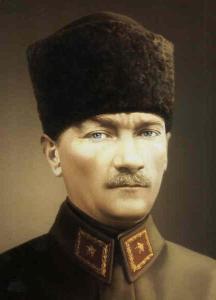Kemalismo marzo 5, 2010
Posted by Lodovico Settembrini in El Reino de este Mundo.Tags: Armenia, EEUU, genocidio, I Guerra Mundial, Turquía
trackback
Seguimos huyendo de la coyuntura.
Aprovechamos la aprobación de una moción de la Comisión de Asuntos Exteriores de la Cámara de Representantes de EEUU, que califica de «genocidio» la matanza de armenios por las fuerzas turcas en la Gran Guerra, para colgar el mejor resumen que hemos podido encontrar en formato electrónico sobre el período. Le robamos hasta el título a la pieza de Perry Anderson.
Expulsada de Europa, la Turquía de los Jóvenes se lanzó sobre el Cáucaso: la derrota – menos de un séptimo de las tropas regresaron – dejó expuesta a la retaguardia y al país: el espacio que separaba ahora a los Aliados de Turquía era habitado por los súbditos armenios del Imperio Otomano que se desgranaba…
In Istanbul, the CUP reacted swiftly. This was no ordinary retreat into the kind of rear where another Battle of the Marne might be fought. The whole swathe of territory extending across both sides of the frontier was home to Armenians. What place could they have in the conflict that had now been unleashed? Historically the oldest inhabitants of the region, indeed of Anatolia at large, they were Christians whose Church – dating from the third century – could claim priority over that of Rome itself. But by the 19th century, unlike Serbs, Bulgars, Greeks or Albanians, they comprised no compact national majority anywhere in their lands of habitation. In 1914, about a quarter were subjects of the Russian, three-quarters of the Ottoman Empire. Under the tsars, they enjoyed no political rights, but as fellow Christians were not persecuted for their religion, and could rise within the imperial administration. Under the sultans, they had been excluded from the devshirme from the start, but could operate as merchants and acquire land, if not offices; and in the course of the 19th century they generated a significant intellectual stratum – the first Ottoman novels were written by Armenians…
The CUP’s immediate fear, as it surveyed the rout of its armies in the Caucasus, was that the local Armenian population might rally to the enemy. On 25 February, it ordered that all Armenian conscripts in its forces be disarmed. The telegrams went out on the day Anglo-French forces began to bombard the Dardanelles, threatening Istanbul itself. Towards the end of March, amid great tension in the capital, the Central Committee – Talat was the prime mover – voted that the entire Armenian population in Anatolia be deported to the deserts of Syria, to secure the Ottoman rear. The operation was to be carried out by the Teskilât-i Mahsusa, the ‘Special Organisation’ created for secret tasks by the party in 1913, now some 30,000 strong under the command of Bahaettin Sakir…
The enterprise on which the CUP embarked in the spring of 1915 was, however, new. For ostensible deportation, brutal enough in itself, was to be the cover for extermination – systematic, state-organised murder of an entire community. The killings began in March, still somewhat haphazardly, as Russian forces began to penetrate into Anatolia. On 20 April, in a climate of increasing fear, there was an Armenian uprising in the city of Van. Five days later, Anglo-French forces staged full-scale landings on the Dardanelles, and contingency plans were laid for transferring the government to the interior, should the capital fall to the Entente. In this emergency, the CUP wasted no time. By early June, centrally directed and co-ordinated destruction of the Armenian population was in full swing. As the leading comparative authority on modern ethnic cleansing, Michael Mann, writes, ‘the escalation from the first incidents to genocide occurred within three months, a much more rapid escalation than Hitler’s later attack on the Jews.’ Sakir – probably more than any other conspirator, the original designer of the CUP – toured the target zones, shadowy and deadly, supervising the slaughter. Without even pretexts of security, Armenians in Western Anatolia were wiped out hundreds of miles from the front…
Çaglar Keyder has described the desperate retroactive peopling of Anatolia with ur-Turks in the shape of Hittites and Trojans as a compensation mechanism for the emptying by ethnic cleansing at the origins of the regime. The repression of that memory created a complicity of silence between rulers and ruled, but no popular bond of the kind that a genuine anti-imperialist struggle would have generated, the War of Independence remaining a small-scale affair, compared with the traumatic mass experience of the First World War. Abstract in its imagination of space, hypomanic in its projection of time, the official ideology assumed a peculiarly ‘preceptorial’ character, with all that the word implies. ‘The choice of the particular founding myth referring national heritage to an obviously invented history, the deterritorialisation of “motherland”, and the studious avoidance and repression of what constituted a shared recent experience, rendered Turkish nationalism exceptionally arid.’…


Comentarios»
No comments yet — be the first.